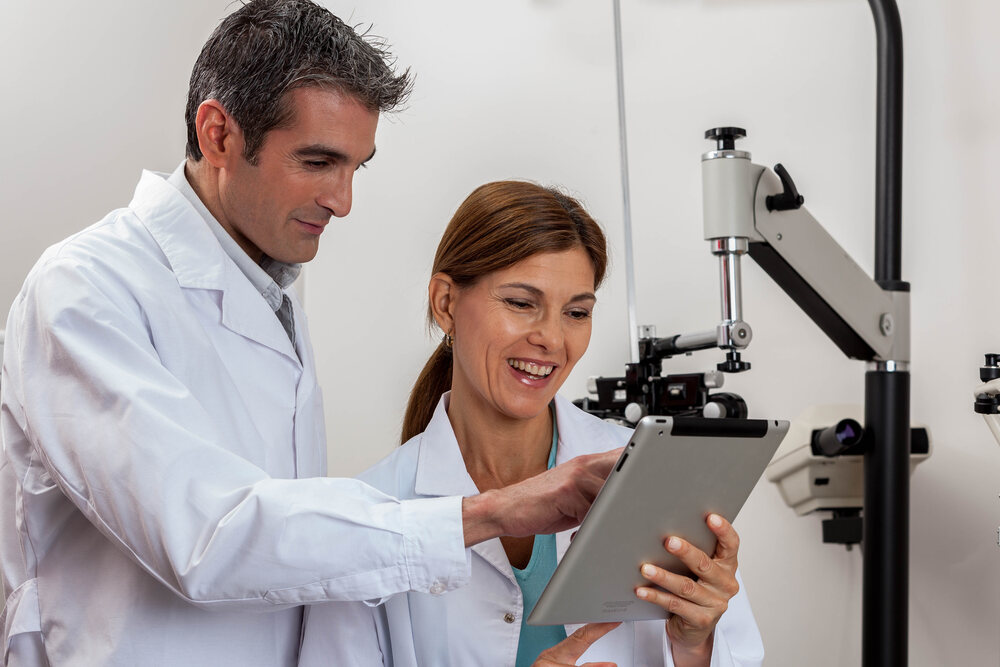Cataracts: Causes, Symptoms, Diagnosis & Treatment
Cataracts Overview
Cataracts are a common age-related eye condition that causes clouding of the eye’s natural lens, leading to blurry, foggy, or dim vision. Over time, cataracts can significantly impair daily activities such as reading, driving, and recognizing faces. Cataracts can lead to vision loss when untreated, so it is important to have regular eye exams and act fast upon diagnosis.
Cataracts typically develop slowly and may not cause noticeable symptoms at first. Most people begin to experience signs in their 60s, though the lens can begin to deteriorate as early as age 40. Fortunately, cataract surgery is a safe and effective solution, performed millions of times each year with high success rates.

What Are Cataracts?
Your eye’s lens helps you focus on objects and images, but it can become clouded over time, obstructing your vision. These cloudy obstructions are called cataracts. Cataracts are usually an age-related condition—when you grow older, proteins in your lens may break apart to form blurry and foggy blots.
Over time, these blurry areas become larger, making daily activities like reading and driving more difficult. Cataracts’ development can be slowed, but eventually, they can lead to vision loss. There are many types of age-related cataracts, each appearing in different parts of your lens.
You likely won’t notice many changes in your sight when you first develop cataracts. You may need to use glasses for certain activities, but cataract symptoms will be relatively mild. As time passes, your ability to see color may diminish, and vision may become too blurry for comfort. If routine activities become a hassle, it may be time to consider cataract surgery.
Most people’s lenses start to deteriorate around age 40, but cataracts usually appear and cause noticeable vision problems around age 60 to 65.
Causes & Risk Factors of Cataracts
Aging is the most common cause of cataracts, but as with any health condition, some people are more at risk than others. If you have experienced eye trauma, have had eye surgery, or have a family history of eye disease, you are more likely to develop cataracts. But there are many other risk factors independent of your eyes.
Be sure to have regular eye exams especially if you:
- Have had prolonged exposure to high-UV sunlight for years.
- Take steroids or have a history of taking steroids.
- Have a family history of diabetes.
- Drink high amounts of alcohol.
- Are a regular smoker or have a history of smoking.
- Experienced lengthy exposure to pollution or chemicals.
There is no sure way to prevent cataracts, but you can take certain measures to reduce your overall risk.
- If you live in a sunny, high-UV climate, wear sunglasses regularly.
- When working with power tools and other dangerous equipment, be sure to wear protective gear like goggles.
- Reduce alcohol consumption and quit smoking.
- Maintain a healthy diet rich in vitamins and antioxidants.
- Schedule regular eye exams, especially if you are at a higher risk for cataracts.
Common Cataracts Symptoms
Cataracts typically bring mild to moderate symptoms in their early stages.
These symptoms include:
Blurry Vision
Difficulty Seeing at Night
High Light Sensitivity
Sometimes, you may not notice them or will discard them as a small inconvenience. Since cataracts usually develop later in life, you may view these symptoms as another part of aging.
If these early symptoms worsen over time, it’s important to talk with an ophthalmologist as soon as possible. An eye exam can determine whether these symptoms are from a cataract or other eye condition.
Advanced symptoms of cataracts can make routine tasks difficult, decreasing your quality of life. Colors may appear yellowed, like pages of an old book. You might also develop double vision in one or both eyes, making driving and reading especially difficult. Many cataract patients also frequently changed their prescriptions before diagnosis. These symptoms aren’t painful but will likely cause discomfort and stress over long periods.

How Cataracts Are Diagnosed
Regular eye exams are critical for detecting cataracts early. If you are aged 60 or older, you should have an eye exam annually. High-risk individuals under 60 should have this exam at least once every two years.
A typical eye exam has three principal parts: the visual acuity test, the slit-lamp examination, and a retinal examination with pupil dilation.
These exams are easy and painless, testing the quality of your vision and searching for any developing conditions. Eye doctors perform a comprehensive inspection of your eyes using advanced machines, flashlights, magnifying glasses, and dilation eye drops. They will also measure your eye pressure and the responsiveness of your eye muscles.
These tests are vital to your eye health and detect more than cataracts. They can diagnose a range of eye conditions, catching serious issues before they cause blindness and other visual impairments.
Treatment Options for Cataracts
Standard cataract surgery, also known as basic cataract surgery, replaces your cloudy lens with a basic intraocular lens (IOL). This procedure can reduce blurry vision and glare but does not correct other vision issues such as astigmatism. This option typically leads to more dependence on glasses and tends to be covered by Medicare and private insurers, not including any co-payment or deductibles that may apply based on your insurance provider and plan.
As its name suggests, laser-assisted cataract surgery uses a laser to perform some steps of the procedure. This allows for greater precision than when the operation is performed entirely by hand, increasing effectiveness and decreasing the risk of complications. It also allows your surgeon to tailor the procedure specifically to your eye, making it an excellent long-term solution for cataracts.
The procedure begins with the doctor numbing the eye so you will not feel pain or discomfort. Next, an imagining device maps your eye. Based on this map, a laser is programmed to make precise incisions in the eye and lens capsule. Once these incisions are made, the laser will break up the cataract into smaller pieces. Finally, the surgeon removes the cataract and inserts an artificial lens.
This quick, outpatient procedure only takes about 20 minutes to complete after which recovery times vary from a few weeks to two months.
What does drop-free/drop-less cataract surgery mean? Typical cataract surgery recovery involves the use of multiple antibiotic and anti-inflammatory medicated eye drops with a complicated dosing schedule. However, drop-free and drop-less cataract surgery eliminates or simplifies this step by including medications in the surgery process.
Post-Op Recovery
Cataract surgery recovery can vary depending on what package you go with; however, for most surgeries, you will see a noticeable improvement in your vision right away. Many patients can resume their normal activities in just a few days, now with clearer vision. During the post-op period on most cataract surgeries, you will be put on a drop regimen that will last for at least a few weeks but possibly up to a few months. Following your procedure, your surgeon will discuss a timetable for post-operative checkups.
The exact benefits you’ll receive from cataract surgery depend on the type of surgery you elect. Explore each option below.
Intraocular Lens (IOL) Options
An intraocular lens implant (IOL) is an artificial, acrylic replacement for the natural lens in your eye. Just like your eye’s natural lens, an IOL implant bends or refracts light rays inside the eye and takes over the image-focusing function in your eye. Simply put, an IOL replaces your eye’s natural lens to provide permanent vision correction eliminating the need for contact lenses or glasses.
There are several IOL options to choose from, which you can read about below.
Monofocal IOLs
A monofocal IOL has one focal point that can be set to focus on objects within close, medium, or far distance based on your preferences. Distance vision is the most common selection and reading glasses are used for seeing close up.
Multifocal IOLs help you see better close up, from medium distances, and far away. Unlike bifocals, where you have to look down to see up close, multifocal IOLs allow you to see both near and far when looking in any direction. Offering a broad range of vision correction, multifocal lenses can correct astigmatism and reduce the need for reading glasses.
LAL-Personalized Light Adjustable Lens
The Light Adjustable Lens (LAL) allows our doctors to continue to customize and make adjustments to your vision after surgery. After the procedure, your eye doctor will test your vision and select a custom prescription for your adjustable lens that fits your lifestyle needs.
Extended Depth of-Focus IOLs are the perfect pick for active individuals who desire a seamless range of functional, high-quality vision, spanning from far to near distances, with the aim of reducing the need for glasses.
Toric IOLs
Toric IOLs are the preferred choice for those with significant astigmatism. Because this condition affects your vision at any distance, and they can be monofocal or trifocal. Before surgery, your surgeon will measure your eyes to determine the correct toric IOL power and the specific orientation needed to correct your eye’s astigmatism.
When to Consider Cataract Surgery
Not everyone with cataracts needs surgery, and few need surgery immediately after diagnosis. You should always consult with an eye doctor before receiving surgery, but a good rule of thumb is that you’ll likely need surgery when your cataract symptoms begin to interfere with your daily life.
What does this look like? If you have difficulty driving, discerning faces, and reading—or if your favorite activities are impossible with your current vision—cataract surgery may be an option to consider. But remember, an eye exam from an experienced eye doctor will determine whether the root cause of your issues is a cataract and whether surgery is a viable option for you.

Frequently Asked Questions
Cataract surgery itself is known for being relatively quick and painless. That said, patients commonly report mild eye discomfort in the first few days following the procedure. Many patients describe their discomfort as eye tenderness, grittiness, or as if a small foreign object is in their eye. Most pain associated with surgery only lasts about 2-3 days and can be managed by taking over-the-counter painkillers like Tylenol or ibuprofen.
Cataracts cannot return after surgery because artificial lenses cannot develop cataracts. But sometimes, artificial lenses can become clouded, presenting cataract-like symptoms.
Typically, you can resume regular activity after cataract surgery after about two weeks. That said, you won’t be able to drive for 24 hours after surgery, so be sure to arrange a ride home from your appointment. In the weeks following surgery, you should avoid swimming, wearing makeup, heavy lifting, high-intensity exercise like jogging and cycling, bending over, and rubbing your eyes. It is also recommended that you wear dark-tinted sunglasses outside. If you have specific concerns about recovery, be sure to discuss them with your eye doctor.
Why Choose Midwest Vision Partners for Cataract Treatment?
Midwest Vision Partners’ eye doctors are nationally recognized for their patient-centric care and usage of advanced technologies. We restore patients’ day-to-day comfort with highly customizable, highly effective treatments that minimize discomfort and maximize success.
A successful cataract surgery allows you to see the world in its unobstructed wonder. Trees are green, faces are smiling, and your whole outlook on life becomes much clearer. We restore eyesight, but we also restore the joys that come with it.
Cataract symptoms can leave you feeling lost, but the eye specialists at Midwest Vision Partners create exemplary treatment plans and conduct successful surgeries daily. We offer standard and premium cataract surgery to restore the vision you deserve, so request an appointment with our eye experts today.
Related Services
Let's Get Started
When It Comes To Eye Health, We’re Your MVP






